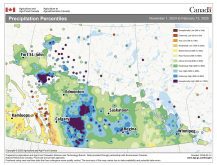Arlan Suderman remains “friendly” on corn despite a startling revision to China’s government stockpile of the commodity.
In its latest World Agricultural Supply and Demand Estimates report, the U.S. Department of Agriculture bumped up China’s ending stocks by a staggering 149 million tonnes.
The USDA revised Chinese corn production upward over the past decade based on new statistics provided by China’s National Bureau of Statistics.
That resulted in a new ending stocks number of 207.5 million tonnes, up from the October estimate of 58.5 million tonnes.
Read Also

Phosphate prices to remain high
Phosphate prices are expected to remain elevated, according to Mosaic’s president.
To put that in perspective, the highest level ending stocks reached over the last 60 years was 124 million tonnes.
Before the revisions, it looked as though China was rapidly running out of its corn reserves, so the new number put a damper on the market.
But Suderman is still friendly corn despite the USDA’s shocking revisions because of what his “boots on the ground” in China are telling him.
“Our sources there that help with the reserve and have knowledge of the reserve indicate that there’s about 80 million tonnes left,” said the chief commodities economist for INTL FCStone.
“That would suggest that they will run out of reserve corn at the current pace sometime in late 2019.”
That is when the world’s second largest corn consumer will likely start importing a lot more and that will have a profound impact on grain markets.
Suderman said there are conflicting reports about the size of China’s annual corn deficit and when that happens he turns to the cash market for guidance.
The Chinese government auctioned off 100 million tonnes of corn between April and October of 2018.
“The cash market saw almost no detrimental effect from all of that corn being dumped onto the market,” he said.
Some of the corn was purchased but not removed from the reserve. The actual amount that hit the market is estimated at around 60 million tonnes, suggesting the deficit is at least that big.
If that is the case, China’s stockpile of the commodity will dwindle and the country will start importing more corn in late 2019-20.
Suderman said a bolstered Chinese import program will boost corn and other grain prices, especially wheat. The wild card is what happens with U.S. corn acres.
The USDA forecasts 91.2 million acres of corn, up from 89.1 million acres last year. Using the trend line yield of 176.5 bushels per acre and assuming record exports and improved ethanol and domestic feed use, there would be 1.38 billion bushels of ending stocks and a friendly 8.9 percent stocks-to-use ratio.
He estimates that would mean a 2019-20 marketing year average cash price of US$4.85 per bushel, which is well above the USDA’s forecast of $3.60 per bu.
Even if he bumps up the average yield to 180 bu. per acre, corn stocks would still be tightening up and the average cash price would be close to the December 2019 futures price of $4.01 per bu.
Bill Nelson, senior economist with Doane, said China’s stocks are effectively out of the market anyway.
“They really can’t export their way out of this situation,” he said.
“They can’t draw down their stocks by shipping it off elsewhere because they’d be violating World Trade Organization rules.”
So when firms like Doane analyze global corn supply and demand, they take China out of the equation and when you do that, global stocks are tightening up.
He agreed with Suderman that 92 million acres of U.S. corn is not a bearish number.
“That doesn’t really get us to a surplus,” he said.
In fact, it’s a “wrinkle in the weather” away from getting really tight, said Nelson.
He believes U.S. corn acres would have to jump by about five million acres to start building stocks. Some people think that is possible.
Soren Schroder, chief executive officer of Bunge, told investment analysts on a recent conference call to expect a big swing out of soybeans and into corn.
“Prices would suggest a significant shift to corn, whether that’s five or 10 million acres, I don’t know,” he said.
Nelson said another possible bearish factor is that South America’s corn crops are off to a good start.
The Soybean and Corn Advisor website said Argentina’s corn crop was 36 percent planted as of Nov. 15 and that 100 to 150 millimetres of rain had fallen on the drought-stricken areas of central Argentina.
Brazil’s soybean crop was planted early in the Mato Grosso region, which means it will be harvested early and the safrinha or second crop of corn will likely be planted in the ideal planting window that closes on Feb. 20.
The earlier the safrinha crop is planted the better the potential yield and the more corn that can be sown, according to the Soybean and Corn Advisor story.
Nelson said the good prospects for the South American corn crop could be blocking a mini-price rally.
“It probably pauses what could be a little stronger forward price outlook for corn,” he said.















